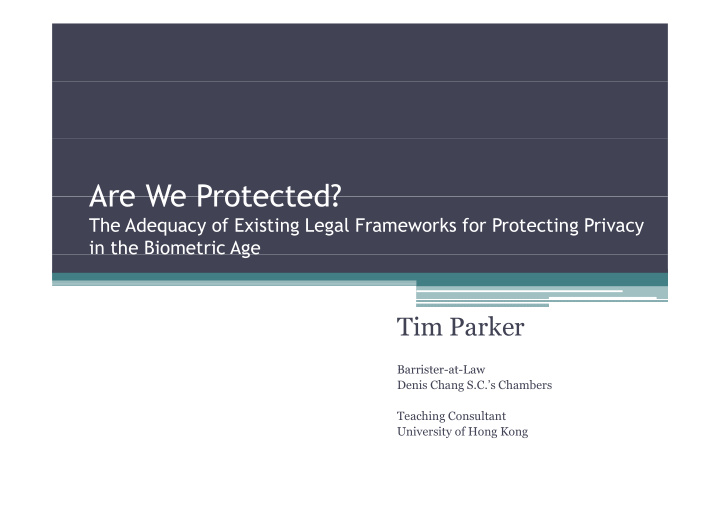



Are We Protected? Are We Protected? The Adequacy of Existing Legal Frameworks for Protecting Privacy in the Biometric Age t e o et c ge Tim Parker Barrister at Law Barrister-at-Law Denis Chang S.C.’s Chambers Teaching Consultant U i University of Hong Kong i f H K
2 Overview Overview • The • The law law of of privacy: privacy: Article Article 17 17 of of the the International Covenant on Civil and Political Rights (1966) Rights (1966) • Privacy impact of biometric data usage • Privacy impact of biometric data usage • Biometrics in Hong Kong SAR and Mainland Bi t i i H K SAR d M i l d China
3 Article 17 ICCPR Article 17 ICCPR 1 1. No one shall be subjected to arbitrary or No one shall be subjected to arbitrary or unlawful interference with his privacy, family, or correspondence nor to unlawful attacks on or correspondence, nor to unlawful attacks on his honour and reputation. 2. Everyone has the right to the protection of the law against such interference or attacks law against such interference or attacks.
4 Article 17 ICCPR Article 17 ICCPR • The right to privacy is neither: • The right to privacy is neither: ▫ Absolute; nor ▫ Non-derogable ▫ Non-derogable. • However strict conditions for limitation: • However, strict conditions for limitation: ▫ “In law” (i.e. legislation); and ▫ “Not arbitrary” ▫ Not arbitrary
5 Article 17 ICCPR Article 17 ICCPR • “Arbitrary” synonymous with “unreasonable” • Arbitrary synonymous with unreasonable ( per UNHRC): ▫ Rational connection to a legitimate purpose ▫ Restriction on the right must be no more than is necessary to accomplish the legitimate purpose necessary to accomplish the legitimate purpose ▫ Proportionality P ti lit
6 Article 17 ICCPR - Sources Article 17 ICCPR - Sources • UN Human Rights Committee General UN Human Rights Committee General Comment No. 16 (Right to Privacy) 1988 • Toonen v Australia [1994] IHLR 27 (UNHRC Communication No. 488/1992) • Leung Kwok Hung & Anor. v Chief Executive of the HKSAR (Unreported, 9 February 2006, HCAL107/2005)(Affirmed by the Court of Final A Appeal in [2006] 3 HKLRD 455) l i [2006] 3 HKLRD 455)
7 Biometrics and privacy Biometrics and privacy • Characteristics intrinsic to biometric data • Characteristics intrinsic to biometric data • Collateral impact of employing biometrics: • Collateral impact of employing biometrics: ▫ Secondary data functions Secondary data functions ▫ Trend towards centralisation/collation ▫ ‘Function (or specification) creep’ ‘F ti ( ifi ti ) ’
8 Biometric Hong Kong ID Cards Biometric Hong Kong ID Cards • Mandatory to possess and carry at all times • Mandatory to possess and carry at all times (Registration of Persons Ordinance) • Introduced “temporarily” for 1949 mass- migration: law and order food distribution etc migration: law and order, food distribution, etc. • Now smart, may be checked without probable N t b h k d ith t b bl cause (including fingerprint scanner match) with auxiliary functions ili f ti
9 Data privacy in the PRC Data privacy in the PRC • No unified data protection law • No unified data protection law • Some piecemeal developments: • Some piecemeal developments: ▫ Amended PRC Criminal Law ▫ Amended Tort Law Amended Tort Law • Prediction: developments likely to be subject to P di i d l lik l b bj wide State security exceptions
Recommend
More recommend